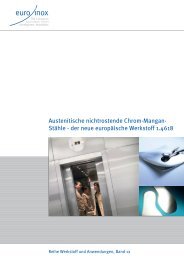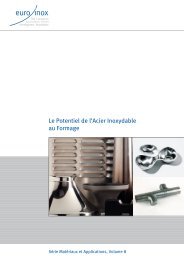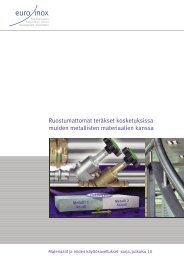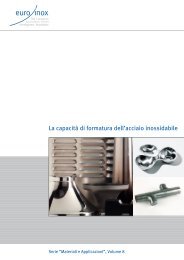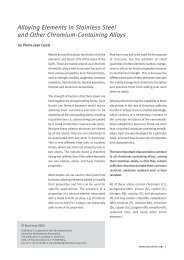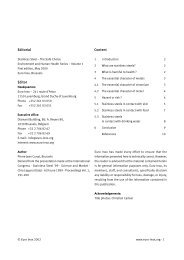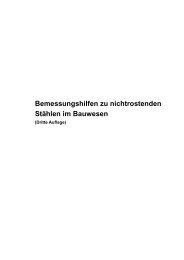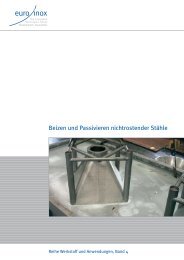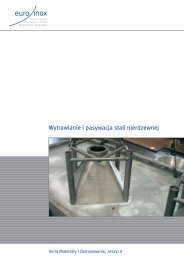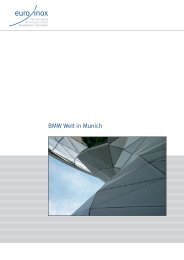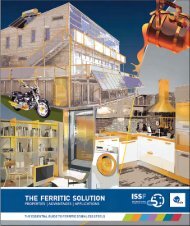Innovative Stainless Steel Applications in transport ... - Euro Inox
Innovative Stainless Steel Applications in transport ... - Euro Inox
Innovative Stainless Steel Applications in transport ... - Euro Inox
Create successful ePaper yourself
Turn your PDF publications into a flip-book with our unique Google optimized e-Paper software.
design and the manufacture of the tube. Tolerances for the radius of outside corners <strong>in</strong><br />
tube form<strong>in</strong>g should correspond, at least, to the standard of the tube manufacturer:<br />
R i = (1.6 – 2.4) T, (3)<br />
<strong>in</strong> which T is the wall thickness of a tube. Due to large bended radii, there are no<br />
significant changes <strong>in</strong> material properties compared to unbent tubes. Spr<strong>in</strong>gback must<br />
be compensated for by adequate overbend<strong>in</strong>g. The spr<strong>in</strong>gback model can be used <strong>in</strong><br />
tube bend<strong>in</strong>g. The target (set) bend<strong>in</strong>g radius <strong>in</strong> three-roll bend<strong>in</strong>g can be calculated<br />
us<strong>in</strong>g the modified equation given earlier, which was verified <strong>in</strong> this study. The<br />
relationship between actual and target bend<strong>in</strong>g radius is moderately l<strong>in</strong>ear for the tubes<br />
made of the sta<strong>in</strong>less steel grades 1.4318 and 304SP (grade 1.4318 <strong>in</strong>clud<strong>in</strong>g two<br />
delivery conditions: 2B and 2H).<br />
It should be noted that the study <strong>in</strong> the DOLTRAC project was based on limited data.<br />
Only one tube dimension, <strong>in</strong> two steel grades, was tested. More tests would be<br />
necessary to determ<strong>in</strong>e reliable statistics for the spr<strong>in</strong>gback behaviour and m<strong>in</strong>imum<br />
bend<strong>in</strong>g radius of rectangular ultra high-strength sta<strong>in</strong>less steel tubes <strong>in</strong> tube bend<strong>in</strong>g.<br />
4.3 Weld<strong>in</strong>g and jo<strong>in</strong><strong>in</strong>g<br />
In the follow<strong>in</strong>g short <strong>in</strong>troduction, only those jo<strong>in</strong><strong>in</strong>g methods considered relevant <strong>in</strong><br />
<strong>in</strong>dustrial-scale production of sta<strong>in</strong>less steel <strong>transport</strong>-vehicle structures are reviewed.<br />
These techniques are divided <strong>in</strong>to four basic groups: arc and laser-based fusion<br />
processes, resistance weld<strong>in</strong>g and solid-state processes (i.e. adhesive bond<strong>in</strong>g) and<br />
comb<strong>in</strong>ations of these.<br />
4.3.1 Arc-based weld<strong>in</strong>g processes<br />
Arc weld<strong>in</strong>g is a group of fusion-weld<strong>in</strong>g processes <strong>in</strong> which the heat required to melt<br />
the materials to be welded is generated by an electric arc. Arc weld<strong>in</strong>g can be divided<br />
<strong>in</strong>to numerous sub-processes and their variants, the ma<strong>in</strong> differences between which are<br />
the type of electrode used (consumable or non-consumable) and the type of shield<strong>in</strong>g<br />
(<strong>in</strong>ert or active gas, slag, powder). The follow<strong>in</strong>g most widely used arc weld<strong>in</strong>g methods<br />
are listed here <strong>in</strong> order of the amounts of filler-metal consumed:<br />
• Metal <strong>in</strong>ert or active gas weld<strong>in</strong>g (MIG/MAG)<br />
• MAG weld<strong>in</strong>g with tubular cored electrode (flux or metal cored arc weld<strong>in</strong>g,<br />
FCAW or MCAW)<br />
• Shielded metal arc weld<strong>in</strong>g with covered electrode (SMA – “stick weld<strong>in</strong>g”)<br />
• Submerged arc weld<strong>in</strong>g (SAW)<br />
82



